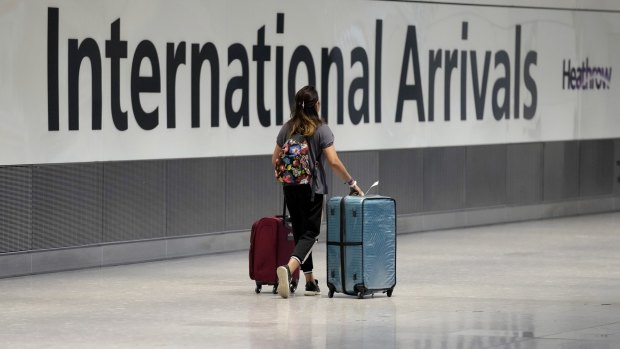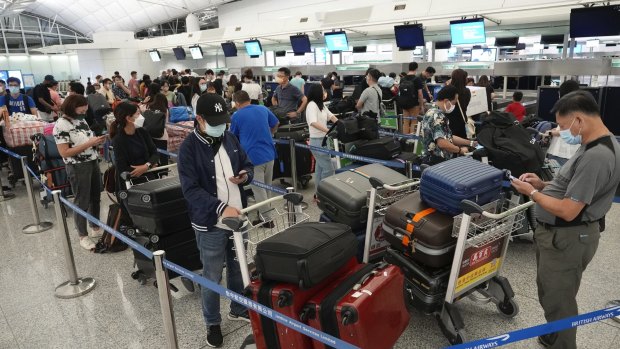This was published 2 years ago
International travel and COVID-19: Flying is a nightmare of changing rules, tests and quarantine
By Shibani Mahtani

Changing international travel rules, virtually on a daily basis, make navigating London's busy Heathrow airport a chaotic experience.Credit: AP
The white desks were spaced exactly 1.5 metres apart and arranged in neat rows – reminiscent of an exam hall. With a green lanyard featuring a bar code around my neck, I took up position at seat G202 E2 and waited for my coronavirus test result at Hong Kong airport.
Had I been reduced to a mere bar code, I wondered, as it dawned on me that this clinical, machine-readable pattern would determine my fate over the coming days.
I was almost home. This was the last step of a five-week trip from Hong Kong to London and then to the United States and back again – a journey filled with paperwork, swabs, QR codes and mobile apps as I navigated a matrix of constantly shifting rules that could upend plans in an instant. The experience showed that normal international travel remains a long way off, especially as the delta variant spreads.

People queue up to check in at Hong Kong International Airport.Credit: AP
Hong Kong has been closed to nearly all nonresidents since March 2020. Until May, most returnees had to quarantine in a hotel for up to 21 days, and that meant being confined to the room – forget about hitting the hotel pool or even opening a window.
When these restrictions were eased to 14 days – then to seven if one was fully vaccinated and could produce an antibody test – I booked my flights, dusted off my passport, renewed my visas and rushed to obtain the necessary tests. I had a two-day window to get the serology test, which had to be done only by a locally accredited lab, to qualify for reduced quarantine. Two vials of blood and a negative coronavirus test later, I was headed to Britain to see my family for the first time in 17 months and meet my newborn nephew.
This was late June, and Hong Kong was on Britain's amber list, so I had to self-quarantine for 10 days or pay for an extra test to end home quarantine early on Day 5. After a negotiation at the airport about whether my name exactly matched the British passenger locator form and some perfunctory questions from a half-awake immigration officer, I was in London enjoying some time at my sister's home with my family. So far, so good.
A few days later, my phone started buzzing: Hong Kong had banned all arrivals from Britain. Between June 20 and June 28, the quarantine requirement I would face on return had gone from 14 days, to seven, to 21 – and then the total ban on arrivals from Britain began.
A new set of negotiations began, this time with editors at The Washington Post and two airlines. To skirt the ban, I would need to spend 21 days elsewhere (not Britain) and then fly back to Hong Kong. I cut short my London trip, rebooked tickets to the United States, and planned to spend 21 days on the West Coast before returning to Hong Kong.
Of course, there was another catch. The United States remains closed to travellers from Britain, even to US visa holders, unless you qualify for certain exemptions. But no one from the U.S. consulates abroad can actually confirm that you qualify. You basically have to bring any documents to prove the exemption, rock up at the airport, and hope for the best.
So again I gathered my papers, my latest coronavirus test result (I was at four swabs in two weeks by this point) and headed to check in at Heathrow Airport. The airline official said she could not check me in without approval from the sole Homeland Security official, who was inundated.
While I waited an hour to be approved, the check-in desk worker described the chaos that unfolds daily at Heathrow. The day before, she said, one country narrowed its window for a pre-departure coronavirus test from 72 hours to 48 hours – meaning most people lining up to check in did not meet the new rule and had to cancel their flights. The woman next to me was headed to Greece but had no idea she needed a coronavirus test, could not produce one, and had to go home.
Eventually I was cleared to travel, and raced to my gate. It didn't matter – after a four-hour delay, my flight to JFK was cancelled because of a problem with the aircraft. I had to start the process over: Enter Britain again through border control, produce a new passenger locator form, and return to Heathrow the next morning with a new coronavirus test result. Again, I would need approval from the Homeland Security official.
This time, luck was on my side.
Once I had arrived in the United States, the next three weeks were a breeze – testament to how restrictions there pale in comparison to the travel landscape almost anywhere else. It was jarring to see unmasked faces indoors and large groups dining in restaurants. When I wore my mask at grocery stores, particularly outside major cities, I got weird looks and stares. When I didn't have it on, my instinct was to keep touching my face, a reflex after 17 months of mask-wearing in almost every setting in Hong Kong – even the gym.
The days went by and soon it was time to return to Hong Kong. The airline, Cathay Pacific, had changed our scheduled flight three times. (Cathay posted a record loss of $3.79 billion in 2020.) My partner and I arrived three hours early, which was just as well because it took about an hour for six people to check all our documents before issuing our boarding passes.
The 16-hour flight was as dreary as ever. After more document-checking and yet another coronavirus test on arrival, we were ushered to the white desks. We were given a thin sandwich, some crackers and a bottle of water.
An hour in, passengers began pacing the room and photographing the dystopian process. One woman was doing exercises, swinging her hands around while walking laps through the mostly deserted hall.
After seven hours, we were cleared for re-entry and taken to a designated bus to our quarantine hotel. En route, a fellow passenger – a bank executive – quipped that the days of landing in Hong Kong and walking in your front door 40 minutes later are long gone. Arriving at the hotel felt like a relief, until the realisation hit that even stepping too far outside the room door is a criminal offence.
I am now nearing the end of the seven-day confinement. Highlights have included playing "basketball" with the wastepaper basket and an exercise ball, deliveries of alcohol from friends, and a swab test on Day 5 (the ninth of the trip). Once we are released, we will need to take three more tests and report the results to Hong Kong's government, or risk a fine.
The city has gone almost two months without a local infection. But sitting in this stuffy room, I can't help but wonder if "zero COVID" is a sustainable strategy for an international financial centre, or really anywhere else. Hong Kong, previously dependent on tourism, will soon start allowing in nonresidents – but only if they submit to the process sketched out in this article.
And by the time my nose is prodded for the last time, I will have had my fill of travel for a long while. Unless they change the rules.
The Washington Post
Correction: An earlier version of this story said the writer "made it home to Australia". The writer's home is Hong Kong and she did not visit Australia on this trip.
Sign up for the Traveller newsletter
The latest travel news, tips and inspiration delivered to your inbox. Sign up now.